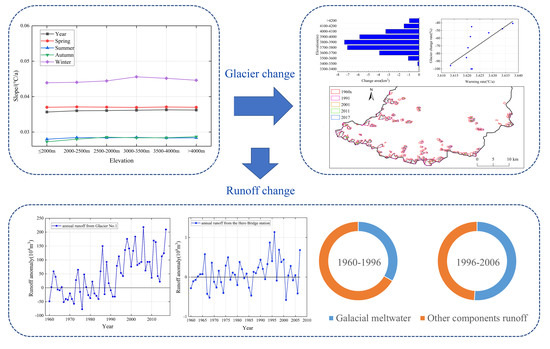Impact of Elevation-Dependent Warming on Runoff Changes in the Headwater Region of Urumqi River Basin
Abstract
1. Introduction
2. Data and Methods
2.1. Study Area
2.2. Data Sources
2.2.1. Landsat Images
2.2.2. Glacier Inventory Data
2.2.3. Temperature Data
2.2.4. Glacier Mass Balance Data
2.2.5. Runoff Data
2.3. Methods
2.3.1. Extent of Glacier Extraction
2.3.2. Estimates of Glacial Storage Volume
2.3.3. Mann–Kendall Nonparametric Tests
3. Results
3.1. Temperature Change
3.2. Glacial Changes
3.2.1. Glacier Area Change
3.2.2. Glacier Area Changes at Different Elevation Zones
3.3. Runoff Changes in the Headwater Region of the URB
3.3.1. Changes in Glacial Meltwater Runoff
3.3.2. Total Runoff Changes in the Headwater Region of the URB
4. Discussion
5. Conclusions
Author Contributions
Funding
Institutional Review Board Statement
Informed Consent Statement
Data Availability Statement
Acknowledgments
Conflicts of Interest
References
- Alexander, L.; Allen, S.; Bindoff, N.L. Climate Change 2013: The Physical Science Basis—Summary for Policymakers; Intergovernmental Panel on Climate Change: Geneva, Switzerland, 2013. [Google Scholar] [CrossRef]
- Barry, R.G. The status of research on glaciers and global glacier recession: A review. Prog. Phys. Geogr. 2006, 30, 285–306. [Google Scholar] [CrossRef]
- Kraaijenbrink, P.D.A.; Stigter, E.E.; Yao, T.; Immerzeel, W.W. Climate change decisive for Asia’s snow meltwater supply. Nat. Clim. Change 2021, 11, 591–597. [Google Scholar] [CrossRef]
- Wang, S.; Zhao, X.; Guo, D.; Huang, Y. Response of permafrost to climate change in the Qinghai-Xizang plateau. J. Glaciol. Geocryol. 1996, 18, 157–165. [Google Scholar]
- Zhu, L.; Xu, S.; Chen, P. Study on the impact of land use/land cover change on soil erosion in mountainous areas. Geogr. Res. 2003, 22, 432–438. [Google Scholar] [CrossRef]
- Beniston, M. Climatic change in mountain regions: A review of possible impacts. Clim. Change 2003, 59, 5–31. [Google Scholar] [CrossRef]
- Krasting, J.P.; Broccoli, A.J.; Dixon, K.W.; Lanzante, J.R. Future changes in northern hemisphere snowfall. J. Clim. 2013, 26, 7813–7828. [Google Scholar] [CrossRef]
- Dariane, A.B.; Khoramian, A.; Santi, E. Investigating spatiotemporal snow cover variability via cloud-free MODIS snow cover product in Central Alborz Region. Remote Sens. Environ. 2017, 202, 152–165. [Google Scholar] [CrossRef]
- Benn, D.I.; Bolch, T.; Hands, K.; Gulley, J.; Luckman, A.; Nicholson, L.I.; Quincey, D.; Thompson, S.; Toumi, R.; Wiseman, S. Response of debris-covered glaciers in the Mount Everest region to recent warming, and implications for outburst flood hazards. Earth-Sci. Rev. 2012, 114, 156–174. [Google Scholar] [CrossRef]
- Lutz, A.F.; Immerzeel, W.W.; Shrestha, A.B.; Bierkens, M.F.P. Consistent increase in High Asia’s runoff due to increasing glacier melt and precipitation. Nat. Clim. Change 2014, 4, 587–592. [Google Scholar] [CrossRef]
- Luo, P.; Mu, Y.; Wang, S.; Zhu, W.; Mishra, B.K.; Huo, A.; Zhou, M.; Lyu, J.; Hu, M.; Duan, W.; et al. Exploring sustainable solutions for the water environment in Chinese and Southeast Asian cities. Ambio 2021, 51, 1199–1218. [Google Scholar] [CrossRef]
- Pepin, N.; Bradley, R.S.; Diaz, H.F.; Baraer, M.; Caceres, E.B.; Forsythe, N.; Fowler, H.; Greenwood, G.; Hashmi, M.Z.; Liu, X.D.; et al. Elevation-dependent warming in mountain regions of the world. Nat. Clim. Change 2015, 5, 424–430. [Google Scholar] [CrossRef]
- Vuille, M.; Bradley, R.S. Mean annual temperature trends and their vertical structure in the tropical Andes. Geophys. Res. Lett. 2000, 27, 3885–3888. [Google Scholar] [CrossRef]
- Beniston, M.; Rebetez, M. Regional behavior of minimum temperatures in Switzerland for the period 1979–1993. Theor. Appl. Climatol. 1996, 53, 231–243. [Google Scholar] [CrossRef]
- Minder, J.R.; Letcher, T.W.; Liu, C. The character and causes of elevation-dependent warming in high-resolution simulations of rocky mountain climate change. J. Clim. 2018, 31, 2093–2113. [Google Scholar] [CrossRef]
- Williamson, S.N.; Zdanowicz, C.; Anslow, F.S.; Clarke, G.K.C.; Copland, L.; Danby, R.K.; Flowers, G.E.; Holdsworth, G.; Jarosch, A.H.; Hik, D.S. Evidence for elevation-dependent warming in the St. Elias Mountains, Yukon, Canada. J. Clim. 2020, 33, 3253–3269. [Google Scholar] [CrossRef]
- Deng, H.; Chen, Y. Influences of recent climate change and human activities on water storage variations in Central Asia. J. Hydrol. 2017, 544, 46–57. [Google Scholar] [CrossRef]
- Pepin, N.; Deng, H.; Zhang, H.; Zhang, F.; Kang, S.; Yao, T. An examination of temperature trends at high elevations across the Tibetan plateau: The use of MODIS LST to understand patterns of elevation-dependent warming. J. Geophys. Res.-Atmos. 2019, 124, 5738–5756. [Google Scholar] [CrossRef]
- Deng, H.; Chen, Y.; Wang, H.; Zhang, S. Climate change with elevation and its potential impact on water resources in the Tianshan Mountains, Central Asia. Glob. Planet Change 2015, 135, 28–37. [Google Scholar] [CrossRef]
- Gao, L.; Deng, H.; Lei, X.; Wei, J.; Chen, Y.; Li, Z.; Ma, M.; Chen, X.; Chen, Y.; Liu, M.; et al. Evidence of elevation-dependent warming from the Chinese Tian Shan. Cryosphere 2021, 15, 5765–5783. [Google Scholar] [CrossRef]
- Shi, Y. Estimation of the water resources affected by climatic warming and glacier shrinkage before 2050 in West China. J. Glaciol. Geocryol. 2012, 23, 333–341. [Google Scholar] [CrossRef]
- Liu, S.; Yao, X.; Guo, W.; Xu, J.; Shang Guan, D.; Wei, J.; Bao, W.; Wu, L. The contemporary glaciers in China based on the Second Chinese Glacier Inventory. Acta Geogr. Sin. 2015, 70, 3–16. [Google Scholar] [CrossRef]
- Yang, X.; Han, T. The variation trends of temperature and precipitation and their influence on glaciers in the headwaters of the Urumqi River. J. Glaciol. Geocryol. 2012, 18, 189–193. [Google Scholar]
- Li, H.; Wang, P. Research on the changes of the Urumqi Glacier No. 1, Tianshan Mountains based on multi-source remote sensing data. J. Glaciol. Geocryol. 2021, 43, 1018–1026. [Google Scholar] [CrossRef]
- Wang, P.; Li, Z.; Zhou, P.; Li, H.; Yu, G.; Xu, C.; Wang, L. Long-term change in ice velocity of Urumqi Glacier No. 1, Tian Shan, China. Cold Reg. Sci. Tech. 2018, 145, 177–184. [Google Scholar] [CrossRef]
- Sun, M.; Li, Z.; Yao, X.; Jin, S. Rapid shrinkage and hydrological response of a typical continental glacier in the arid region of northwest China—Taking Urumqi Glacier No.1 as an example. Ecohydrology 2013, 6, 909–916. [Google Scholar] [CrossRef]
- XiangYing, L.; YongJian, D.; BaiSheng, Y.; TianDing, H. Changes in physical features of Glacier No. 1 of the Tianshan Mountains in response to climate change. Chin. Sci. Bull. 2011, 56, 2820–2827. [Google Scholar] [CrossRef]
- Li, X. Urumqi River Basin Journal; Xinjiang People’s Publishing House: Xinjiang, China, 2000; ISBN 7-228-05739-2. [Google Scholar]
- Zhang, R. Urumqi River water resources evaluation study. Water Conserv. Sci. Technol. Econ. 2010, 16, 179–182. [Google Scholar] [CrossRef]
- Wu, S.; Liu, Z.; Han, P.; Zhu, Y. Impact of climate change on water resources of the Ürüqi River basin. J. Glaciol. Geocryol. 2012, 28, 703–706. [Google Scholar] [CrossRef]
- Jia, Y.; Li, Z.; Jin, S.; Xu, C.; Deng, H.; Zhang, M. Runoff changes from Urumqi Glacier No. 1 over the past 60 years, Eastern Tianshan, Central Asia. Water 2020, 12, 1286. [Google Scholar] [CrossRef]
- Veettil, B.K.; Bremer, U.F.; Grondona, A.E.B.; De Souza, S.F. Recent changes occurred in the terminus of the Debriscovered Bilafond Glacier in the Karakoram Himalayas using remotely sensed images and digital elevation models (1978–2011). J. Mt. Sci. 2014, 11, 398–406. [Google Scholar] [CrossRef]
- Pope, A.; Rees, G. Using in situ spectra to explore Landsat classification of glacier surfaces. Int. J. Appl. Earth Obs. 2014, 27, 42–52. [Google Scholar] [CrossRef]
- Guo, W.; Liu, S.; Xu, J.; Wei, J.; Ding, L. Monitoring recent surging of the Yulinchuan Glacier on North Slopes of Muztag Range by remote sensing. J. Glaciol. Geocryol. 2012, 34, 765–774. [Google Scholar]
- Hall, D.K.; Bayr, K.J.; Schöner, W.; Bindschadler, R.A.; Chien, J.Y.L. Consideration of the errors inherent in mapping historical glacier positions in Austria from the ground and space (1893–2001). Remote Sens. Environ. 2003, 86, 566–577. [Google Scholar] [CrossRef]
- Liu, S.Y.; Sun, W.X.; Shen, Y.P.; Li, G. Glacier changes since the Little Ice Age maximum in the western Qilian Shan, northwest China, and consequences of glacier runoff for water supply. J. Glaciol. 2003, 49, 117–124. [Google Scholar] [CrossRef]
- Burn, D.H.; Elnur, M.a.H. Detection of hydrologic trends and variability. J. Hydrol. 2002, 255, 107–122. [Google Scholar] [CrossRef]
- Sen, K.P. Estimates of the regression coefficient based on Kendall’s Tau. Publ. Am. Stat. Assoc. 1968, 63, 1379–1389. [Google Scholar] [CrossRef]
- Huang, J.; Chen, W.; Wen, Z.; Zhang, G.; Li, Z.; Zuo, Z.; Zhao, Q. Chinese atmospheric science research since the founding of New China 70 years ago: Climate and climate change Climate Change. Sci. Sin.-Terrae 2019, 49, 1607–1640. [Google Scholar] [CrossRef]
- Li, Z.; Ding, Y.; Chen, A.; Zhang, Z.; Zhang, S. Characteristics of warming hiatus of the climate change in Northwest China from 1960 to 2019. Acta Geogr. Sin. 2020, 75, 1845–1859. [Google Scholar] [CrossRef]
- Alexander, L.; Allen, S.; Bindoff, N.; Breon, F.-M.; Church, J.; Cubasch, U.; Emori, S.; Forster, P.; Friedlingstein, P.; Gillett, N.; et al. Climate change 2013: The physical science basis, in contribution of Working Group I (WGI) to the Fifth Assessment Report (AR5) of the Intergovernmental Panel on Climate Change (IPCC). In Climate Change 2013: The Physical Science Basis; Intergovernmental Panel on Climate Change: Geneva, Switzerland, 2013. [Google Scholar] [CrossRef]
- Yao, J.; Yang, Q.; Liu, Z.; Li, C. Spatio-temporal change of precipitation in arid region of the Northwest China. Acta Ecol. Sin. 2015, 35, 5846–5855. [Google Scholar] [CrossRef]
- Li, B.; Chen, Y.; Shi, X. Does elevation dependent warming exist in high mountain Asia? Environ. Res. Lett. 2020, 15, 024012. [Google Scholar] [CrossRef]
- Xu, M.; Kang, S.; Wu, H.; Yuan, X. Detection of spatio-temporal variability of air temperature and precipitation based on long-term meteorological station observations over Tianshan Mountains, Central Asia. Atmos. Res. 2018, 203, 141–163. [Google Scholar] [CrossRef]
- Li, R.; Zhang, M.; Jin, S.; Xiong, Y.; Liu, Y. Regional difference and catastrophe of climate change over Urumqi River Basin. Acta Geogr. Sin. 2010, 33, 243–250. [Google Scholar] [CrossRef]
- Ali, I.; Shukla, A.; Romshoo, S.A. Assessing linkages between spatial facies changes and dimensional variations of glaciers in the upper Indus Basin, western Himalaya. Geomorphology 2017, 284, 115–129. [Google Scholar] [CrossRef]
- Shi, Y. Concise Catalogue of Chinese Glaciers; Shanghai Popular Science Press: Shanghai, China, 2005. [Google Scholar]
- Xu, L.; Li, P.; Li, Z.; Zhang, Z.; Wang, P.; Xu, C. Advances in research on changes and effects of glaciers in Xinjiang mountains. Adv. Water Sci. 2020, 31, 946–959. [Google Scholar] [CrossRef]
- Liu, C.; Kang, E.; Liu, S.Y.; Chen, J.; Liu, Z. A study of glacier changes and their runoff effects in the Northwest Arid Zone. Sci. China Ser. D 1999, 29, 55–62. [Google Scholar] [CrossRef]
- Wang, S.; Zhang, M.; Li, Z.; Wang, F.; Li, H.; Li, Y.; Huang, X. Response of glacier area variation to climate change in Chinese Tianshan Mountains in the past 50 years. Acta Geogr. Sin. 2011, 66, 38–46. [Google Scholar] [CrossRef]
- Ye, B.; Ding, Y.; Liu, C. Response of valley glaciers in various size and their runoff to climate change. J. Glaciol. Geocryol. 2001, 23, 103–110. [Google Scholar] [CrossRef]
- Huai, B.; Wang, Y.; Li, Z.; Sun, W.; Wang, X. Glacier changes and its effect on water resources in Urumqi River Basin, Tianshan Mountains, China, from 1964 to 2014. Arab. J. Geosci. 2018, 11, 716. [Google Scholar] [CrossRef]
- Baojuan, H.; Zhongqin, L.; Meiping, S.; Wenbin, W.; Shang, J.; Kaiming, L. Change in glacier area and thickness in the Tomur Peak, western Chinese Tien Shan over the past four decades. J. Earth Syst. Sci. 2015, 124, 353–363. [Google Scholar] [CrossRef]
- Zhang, Q.; Chen, Y.; Li, Z.; Li, Y.; Xiang, Y.; Bian, W. Glacier changes from 1975 to 2016 in the Aksu River Basin, Central Tianshan Mountains. J. Geogr. Sci. 2019, 29, 984–1000. [Google Scholar] [CrossRef]
- Li, D.-S.; Cui, B.-L.; Wang, Y.; Xiao, B.; Jiang, B.-F. Glacier extent changes and possible causes in the Hala Lake Basin of Qinghai-Tibet Plateau. J. Mt. Sci. 2019, 16, 1571–1583. [Google Scholar] [CrossRef]
- Kaldybayev, A.; Chen, Y.; Vilesov, E. Glacier change in the Karatal river basin, Zhetysu (Dzhungar) Alatau, Kazakhstan. Ann. Glaciol. 2016, 57, 11–19. [Google Scholar] [CrossRef]
- Baojuan, H.; Weijun, S.; Yetang, W.; Zhongqin, L. Glacier shrinkage in the Chinese Tien Shan Mountains from 1959/1972 to 2010/2012. Arct. Antarct. Alp. Res. 2017, 49, 213–225. [Google Scholar] [CrossRef][Green Version]
- Li, Y. Glacier changes and their linkage to the climate-topographic context in the Borohoro Mountains, Tian Shan 1977–2018. Water 2020, 12, 1502. [Google Scholar] [CrossRef]
- Ren, J.; Qing, D.; Kang, S.; Hou, S.; Pu, J.; Jin, Z. Characteristics of glacial change and climatic warming and drying in the Central Himalayas. Chin. Sci. Bull. 2003, 48, 2478–2482. [Google Scholar] [CrossRef]
- Wang, N.; Zhang, X. Mountain glacier fluctuations and climatic change during the last 100 years. J. Glaciol. Geocryol. 1992, 14, 242–250. [Google Scholar]
- Zemp, M.; Huss, M.; Thibert, E.; Eckert, N.; McNabb, R.; Huber, J.; Barandun, M.; Machguth, H.; Nussbaumer, S.U.; Gärtner-Roer, I.; et al. Global glacier mass changes and their contributions to sea-level rise from 1961 to 2016. Nature 2019, 568, 382–386. [Google Scholar] [CrossRef]
- Huss, M.; Hock, R. A new model for global glacier change and sea-level rise. Front. Earth Sci. 2015, 3, 54. [Google Scholar] [CrossRef]
- Marzeion, B.; Jarosch, A.H.; Hofer, M. Past and future sea-level change from the surface mass balance of glaciers. Cryosphere 2012, 6, 1295–1322. [Google Scholar] [CrossRef]
- Farinotti, D.; Huss, M.; Fürst, J.J.; Landmann, J.; Machguth, H.; Maussion, F.; Pandit, A. A consensus estimate for the ice thickness distribution of all glaciers on Earth. Nat. Geosci. 2019, 12, 168–173. [Google Scholar] [CrossRef]
- Huss, M.; Hock, R. Global-scale hydrological response to future glacier mass loss. Nat. Clim. Change 2018, 8, 135–140. [Google Scholar] [CrossRef]
- Xie, Z.; Wang, X.; Kang, E.; Feng, Q.; Li, Q.; Chen, L. Glacial runoff in China: An evaluation and prediction for the future 50 years. J. Glaciol. Geocryol. 2006, 28, 457–466. [Google Scholar]
- Han, T.; Ye, B.; Ding, Y.; Jiao, K. Increasing runoff in the Ürüqi River Basin since 1980s. J. Glaciol. Geocryol. 2005, 27, 655–659. [Google Scholar]
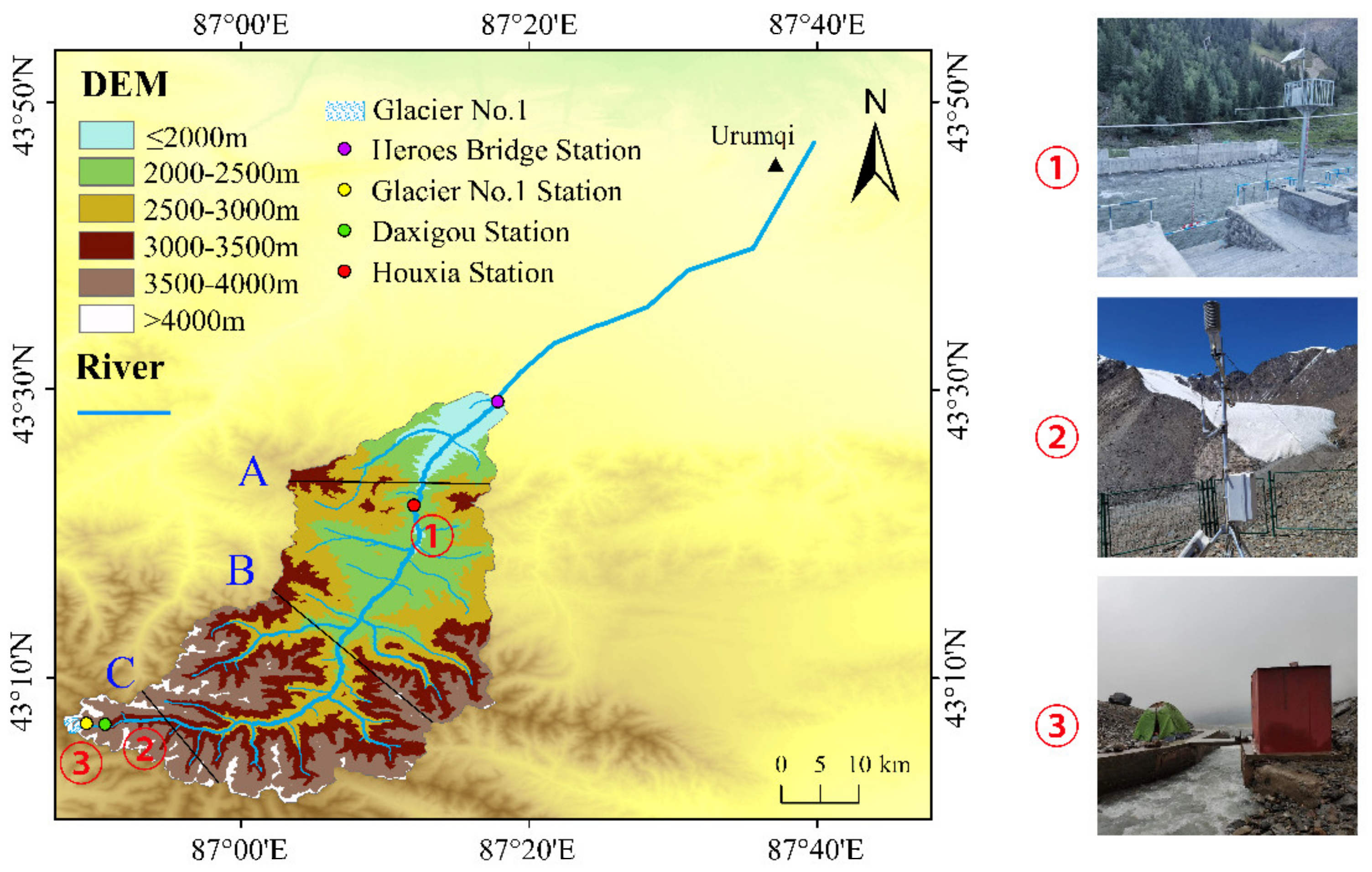
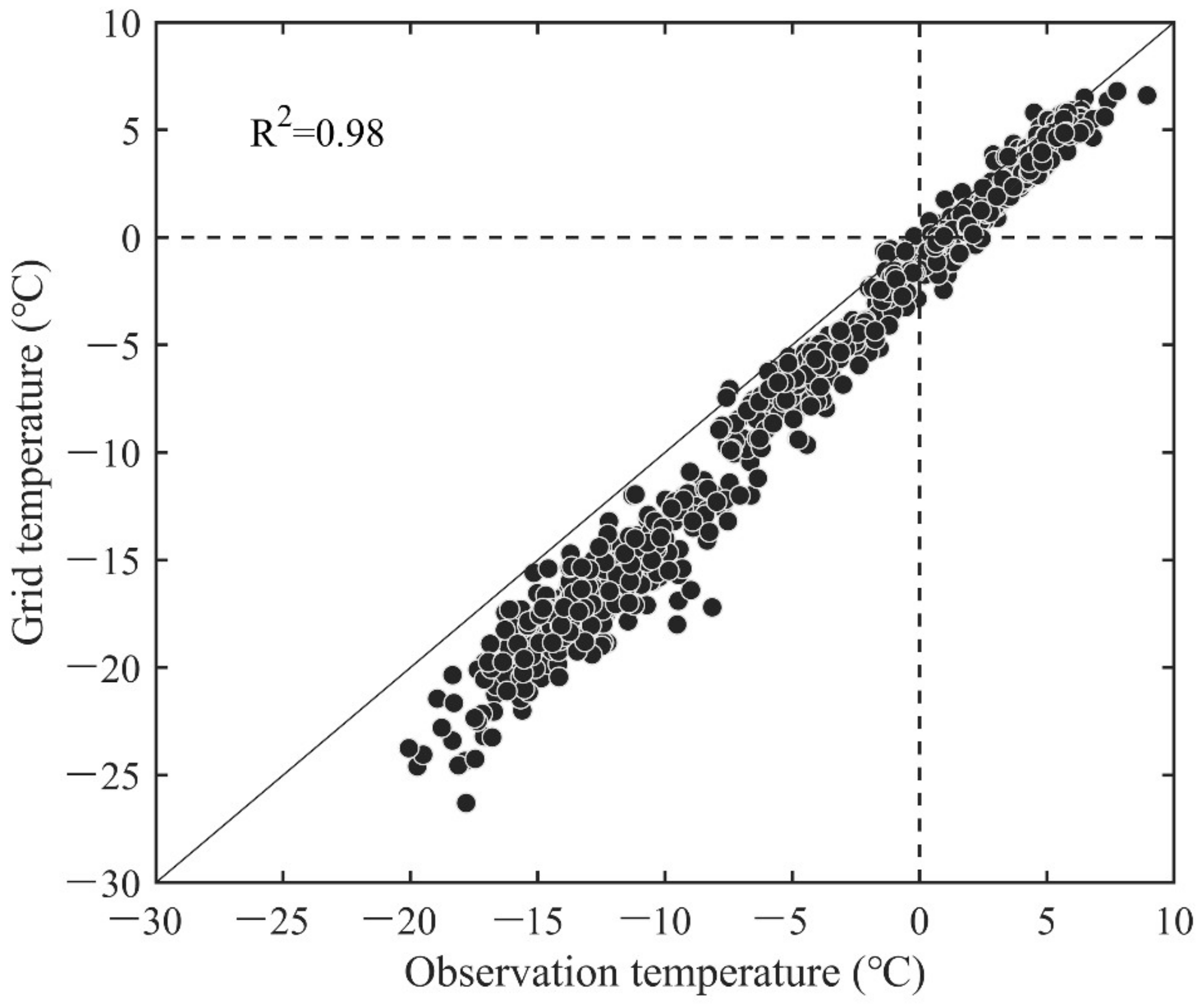

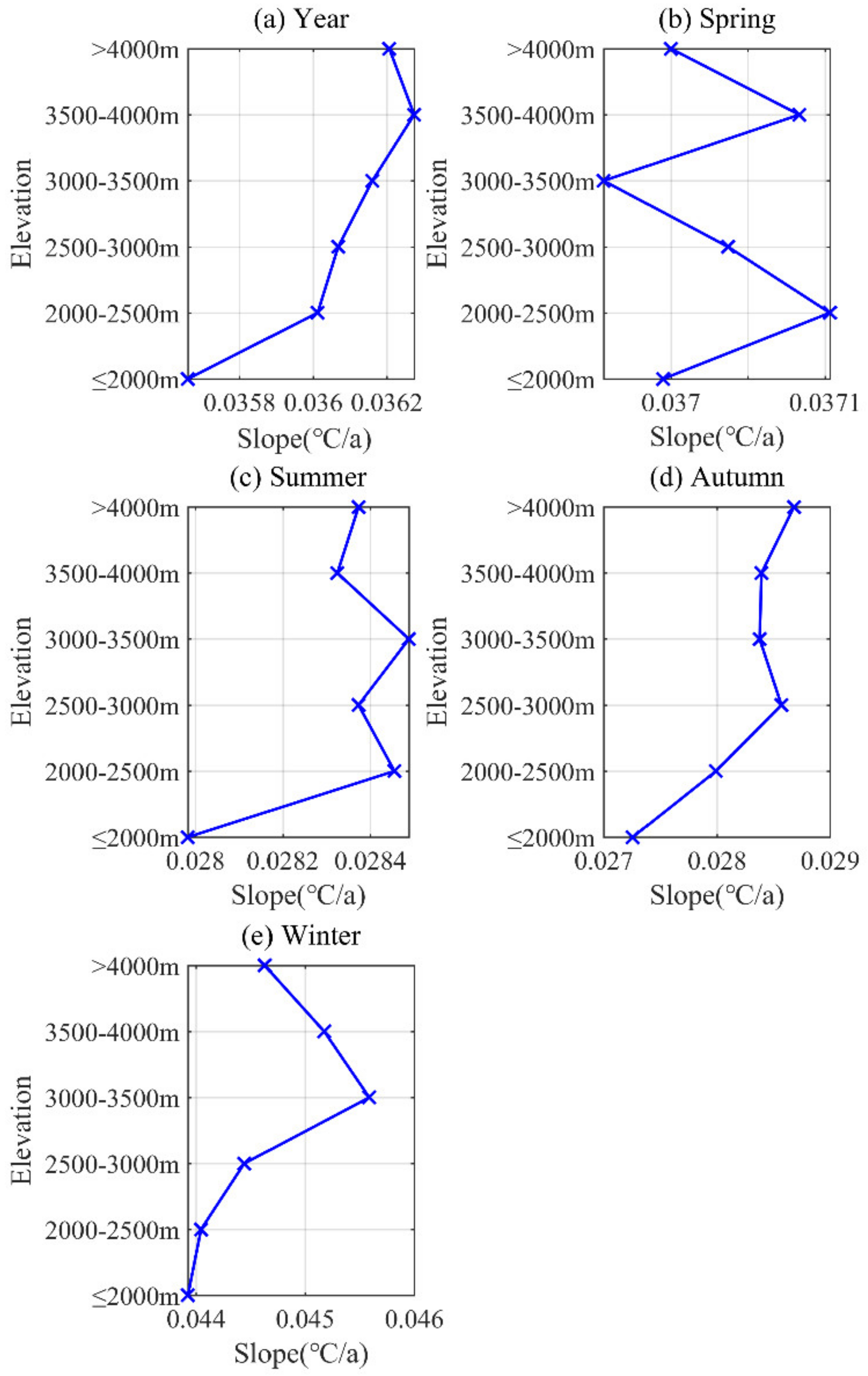

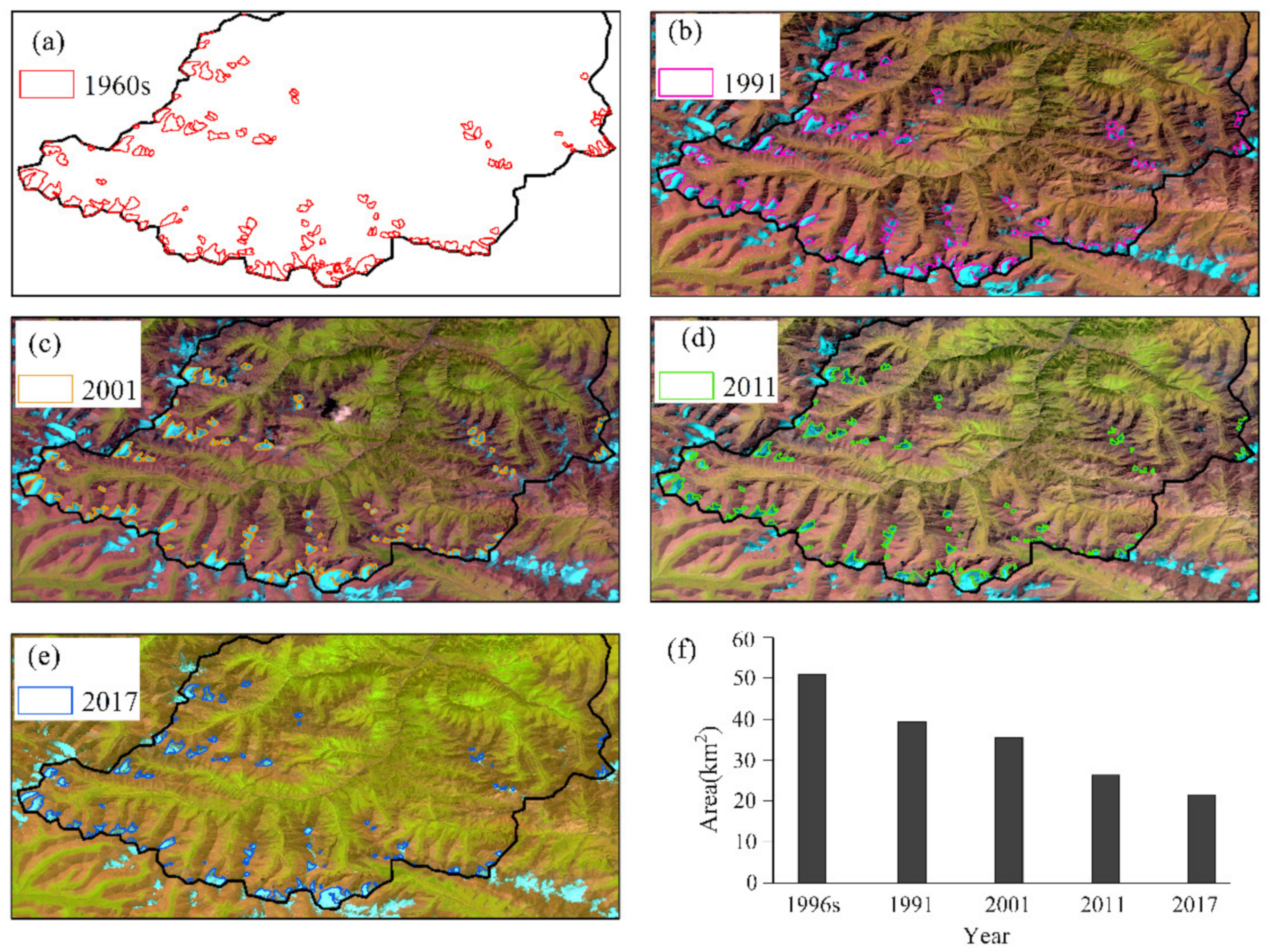
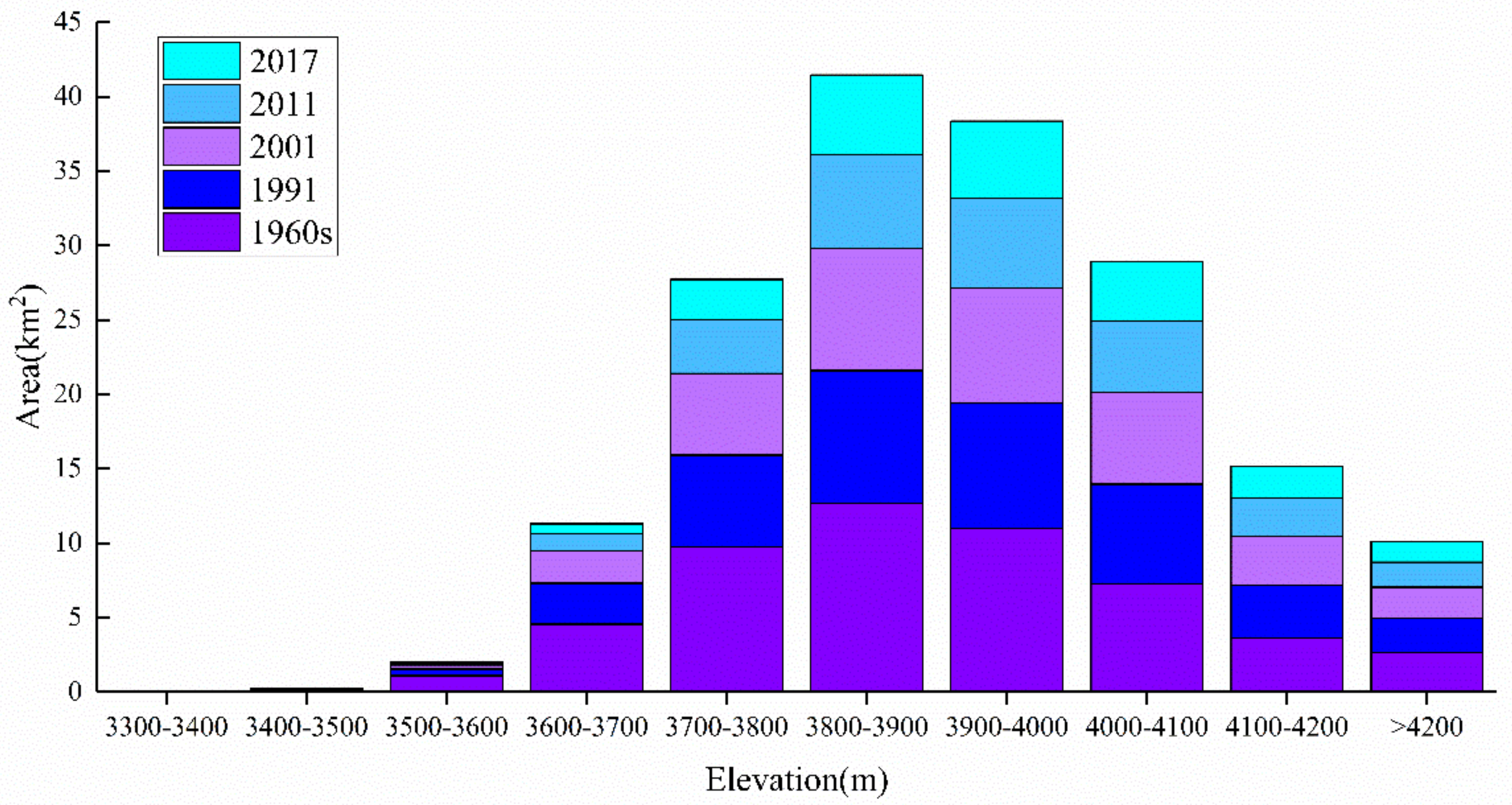
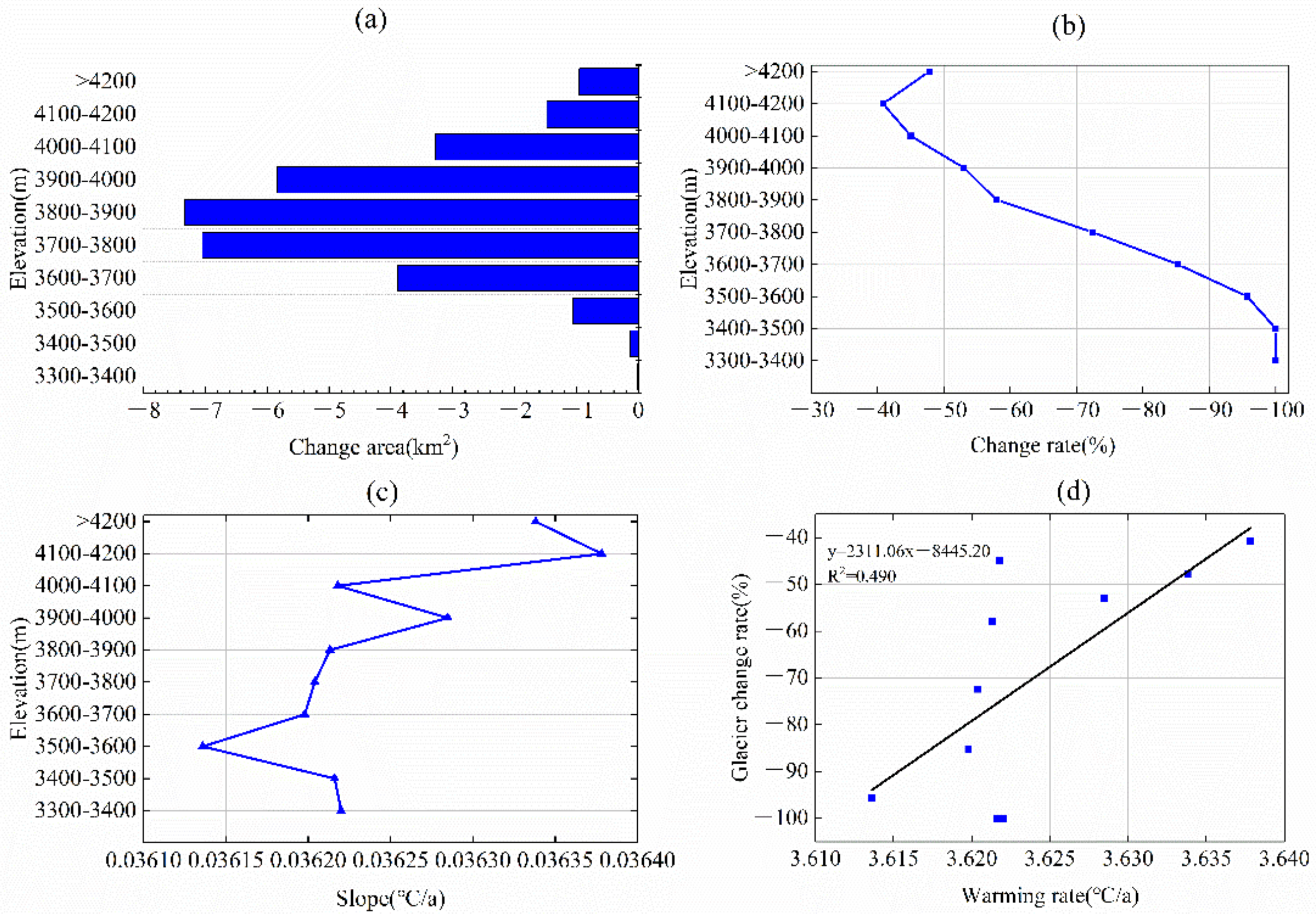
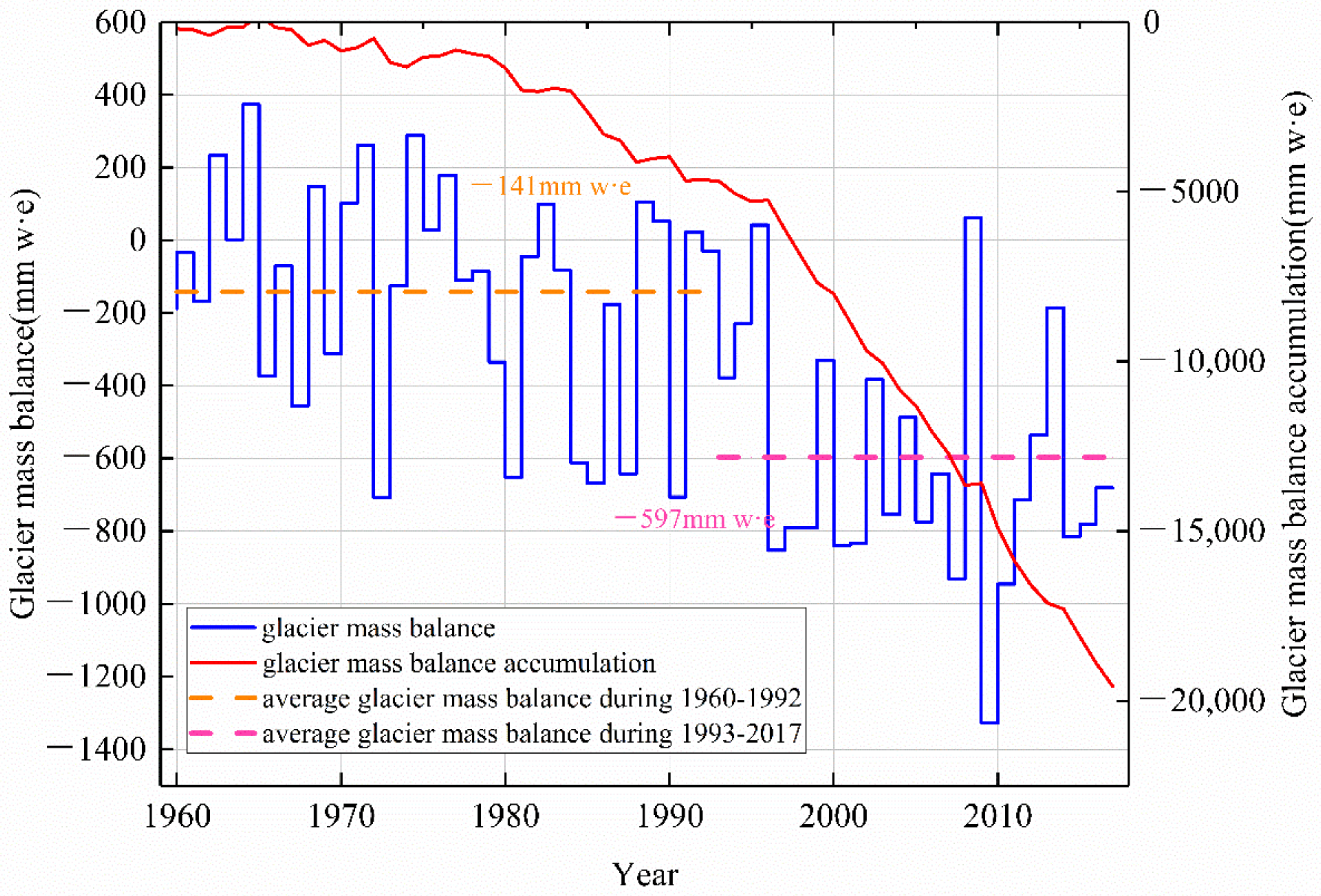
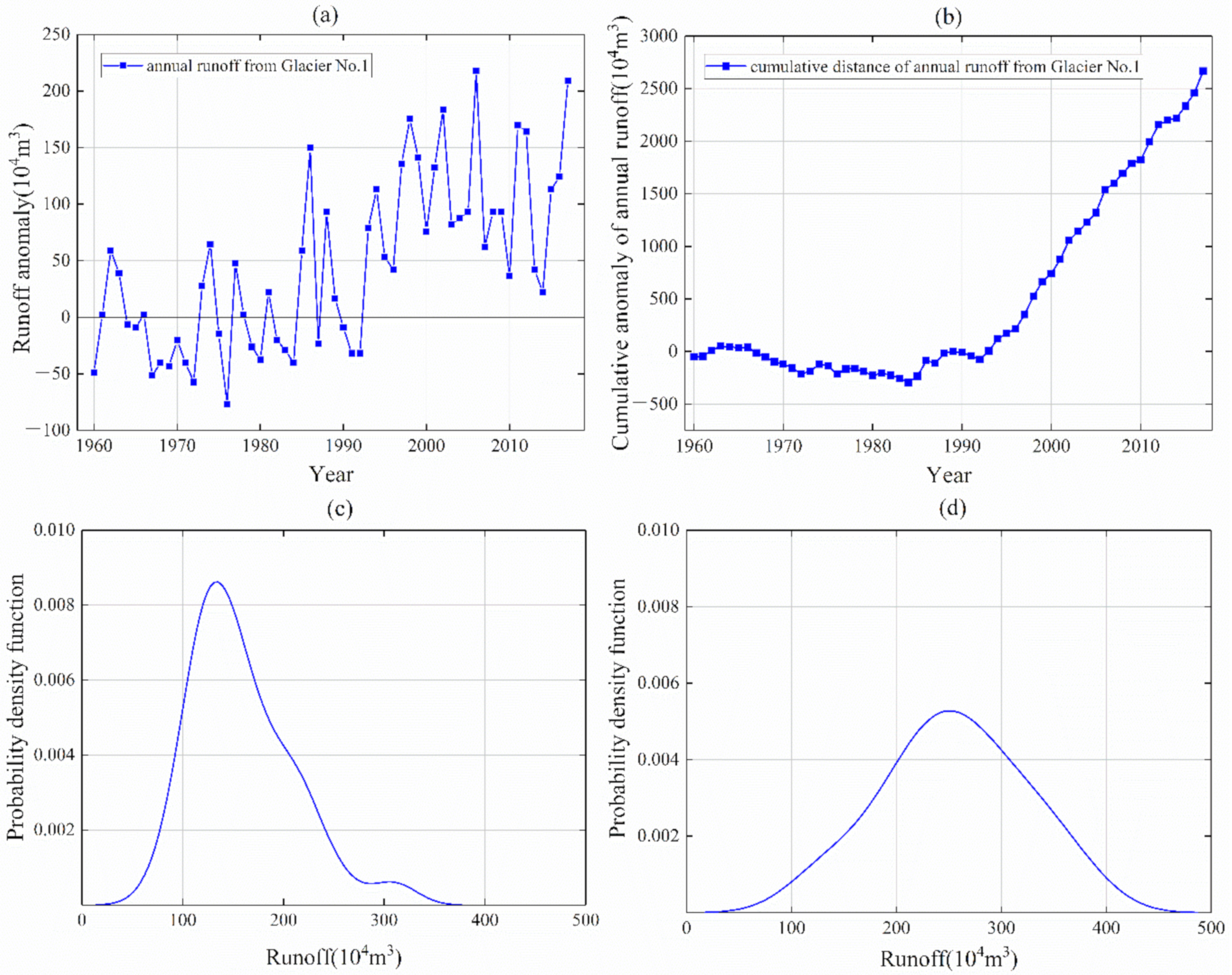
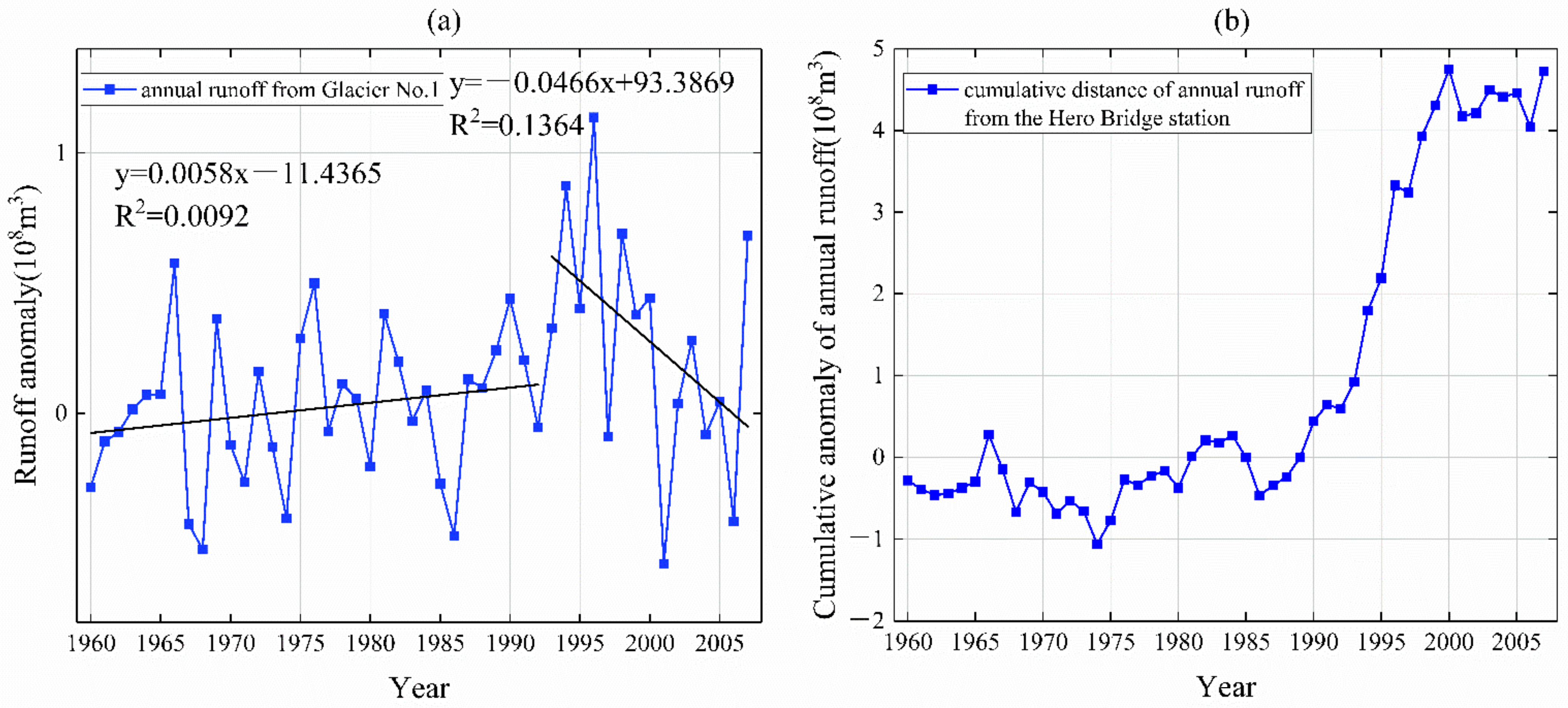
| Year | Sensors | Obtaining Data | Cloudiness (%) | Resolution (m) | Image Information | Reference Image |
|---|---|---|---|---|---|---|
| 1991 | TM | 1 September 1991 | 1 | 30 | LT51430301991244BJC01 | 29 August 1996 |
| 1996 | TM | 29 August 1996 | 0 | 30 | LT51430301996242ISP00 | 28 July 1996 |
| 2001 | TM | 10 July 2001 | 12 | 30 | LT51430302001191BJC00 | 28 July 1996 |
| 2002 | TM | 15 September 2002 | 21 | 30 | LT51430302002258BJC01 | 14 August 2002 |
| 2003 | TM | 17 August 2003 | 1 | 30 | LT51430302003229BJC00 | 15 September 2002 |
| 2004 | TM | 2 July 2004 | 11 | 30 | LT51430302004184BJC00 | 17 August 2003 |
| 2005 | TM | 7 September 2005 | 1 | 30 | LT51430302005250BJC00 | 2 July 2004 |
| 2006 | ETM | 1 August 2006 | 2 | 30/15 | LE71430302006213ASN00 | 7 September 2005 |
| 2008 | TM | 30 August 2008 | 21 | 30 | LT51430302008243BJC00 | 1 August 2006 |
| 2009 | ETM | 25 August 2009 | 1 | 30/15 | LE71430302009237ASN00 | 30 August 2008 |
| 2010 | TM | 20 August 2010 4 August 2010 | 1 8 | 30 30 | LT51430302010232IKR00 LT51430302010216IKR00 | 30 August 2008 |
| 2011 | TM | 23 August 2011 | 0 | 30 | LT51430302011235KHC01 | 20 August 2010 |
| 2012 | ETM | 2 September 2012 | 0 | 30/15 | LE71430302012246PFS00 | 23 August 2011 |
| 2013 | OLI_TIRS | 28 August 2013 27 July 2013 | 1.22 6.31 | 30/15 30/15 | LC81430302013240LGN01 LC81430302013208LGN01 | 2 September 2012 |
| 2014 | OLI_TIRS | 31 August 2014 | 1.32 | 30/15 | LC81430302014243LGN01 | 28 August 2013 |
| 2015 | OLI_TIRS | 18 August 2015 | 1.76 | 30/15 | LC81430302015230LGN01 | 31 August 2014 |
| 2016 | OLI_TIRS | 4 August 2016 | 1.72 | 30/15 | LC81430302016217LGN02 | 18 August 2015 |
| 2017 | OLI_TIRS | 22 July 2017 | 1.24 | 30/15 | LC81430302017203LGN00 | 4 August 2016 |
| Elevation Zone | Mean (°C) | Std | Trend (°C/Decade) | p-Value |
|---|---|---|---|---|
| ≤2000 m | 2.91 | 0.824 | 0.357 | ** |
| 2000–2500 m | 1.31 | 0.827 | 0.360 | ** |
| 2500–3000 m | −1.13 | 0.825 | 0.361 | ** |
| 3000–3500 m | −4.34 | 0.823 | 0.362 | ** |
| 3500–4000 m | −6.78 | 0.824 | 0.363 | ** |
| >4000 m | −8.50 | 0.822 | 0.362 | ** |
| Study region | −2.72 | 0.824 | 0.362 | ** |
| Variables | Abrupt Years | Mean Value before Abrupt | Mean Value after Abrupt | Difference |
|---|---|---|---|---|
| Average annual temperature (°C) | 1990 | −3.27 | −2.14 | 1.13 |
| Mass balance of Glacier No. 1 (mm w·e) | 1993 | −141 | −597 | −456 |
| Meltwater runoff of glacier No. 1 (104 m3) | 1993 | 157 | 269 | 112 |
| Periods | Area (km2) | Glacier Storage (km3) | Rate of Change Relative to 1960s | Rate of Change Relative to 1991 | ||
|---|---|---|---|---|---|---|
| Area | Glacier Storage | Area | Glacier Storage | |||
| 1960s a | 50.95 | 8.07 | 100% | 100% | - | - |
| 1991 | 39.33 | 5.69 | −22.8% | −29.5% | 100% | 100% |
| 1996 | 37.74 | 5.38 | −25.9% | −33.4% | −4.1% | −5.5% |
| 2001 | 35.52 | 4.96 | −30.3% | −38.6% | −9.7% | −12.9% |
| 2006 | 29.26 | 3.82 | −42.6% | −52.7% | −25.6% | −32.9% |
| 2011 | 26.32 | 3.31 | −48.4% | −59.0% | −33.1% | −41.9% |
| 2017 | 21.50 | 2.52 | −57.8% | −68.8% | −45.3% | −55.8% |
| Study Area | Images Sources | Resolution | Mean Errors | References |
|---|---|---|---|---|
| Tomur Peak | Landsat ETM+ | 15 m | ±0.002 km2 | Huai et.al., 2015 [53] |
| Aksu River basin | Landsat MSS/TM/ETM+/OLI | 79 m/30 m/15 m | ±0.5 pixel | Zhang et.al., 2019 [54] |
| Hala Lake Basin | Landsat MSS/TM/ETM+/OLI | 79 m/30 m/15 m | - | Li et.al., 2019 [55] |
| Urumqi River Basin | SPOT5 Landsat ETM+ | 5 m/15 m | ±0.003 km2 ±0.0001 km2 | Huai et.al., 2018 [52] |
| Karatal river basin | Landsat TM/ETM+ | 30 m/15 m | <5% | Azamat et al., 2016 [56] |
| Tian Shan | Landsat TM/ETM+ | 30 m/15 m | <6% | Huai et al., 2017 [57] |
| Tian Shan | Landsat TM Sentinel-2 Hexagon | 30 m/10 m/20 m | <2.6% <1.9% <2.9% | Li et.al., 2020 [58] |
| Urumqi River Basin | Landsat TM/ETM+/OLI | 30 m/15 m | ±0.002 km2 ±0.01 km2 | This study |
Publisher’s Note: MDPI stays neutral with regard to jurisdictional claims in published maps and institutional affiliations. |
© 2022 by the authors. Licensee MDPI, Basel, Switzerland. This article is an open access article distributed under the terms and conditions of the Creative Commons Attribution (CC BY) license (https://creativecommons.org/licenses/by/4.0/).
Share and Cite
Zheng, Z.; Hong, S.; Deng, H.; Li, Z.; Jin, S.; Chen, X.; Gao, L.; Chen, Y.; Liu, M.; Luo, P. Impact of Elevation-Dependent Warming on Runoff Changes in the Headwater Region of Urumqi River Basin. Remote Sens. 2022, 14, 1780. https://doi.org/10.3390/rs14081780
Zheng Z, Hong S, Deng H, Li Z, Jin S, Chen X, Gao L, Chen Y, Liu M, Luo P. Impact of Elevation-Dependent Warming on Runoff Changes in the Headwater Region of Urumqi River Basin. Remote Sensing. 2022; 14(8):1780. https://doi.org/10.3390/rs14081780
Chicago/Turabian StyleZheng, Zhouyao, Sheng Hong, Haijun Deng, Zhongqin Li, Shuang Jin, Xingwei Chen, Lu Gao, Ying Chen, Meibing Liu, and Pingping Luo. 2022. "Impact of Elevation-Dependent Warming on Runoff Changes in the Headwater Region of Urumqi River Basin" Remote Sensing 14, no. 8: 1780. https://doi.org/10.3390/rs14081780
APA StyleZheng, Z., Hong, S., Deng, H., Li, Z., Jin, S., Chen, X., Gao, L., Chen, Y., Liu, M., & Luo, P. (2022). Impact of Elevation-Dependent Warming on Runoff Changes in the Headwater Region of Urumqi River Basin. Remote Sensing, 14(8), 1780. https://doi.org/10.3390/rs14081780








